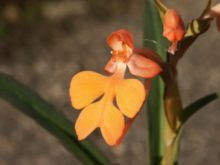Orchideae
| Orchideae | ||||||||||||
|---|---|---|---|---|---|---|---|---|---|---|---|---|

Four-point orchid ( Orchis quadripunctata ) |
||||||||||||
| Systematics | ||||||||||||
|
||||||||||||
| Scientific name | ||||||||||||
| Orchideae | ||||||||||||
| ( Dressl. & Dods. ) Verm. |
Orchideae is a tribe in the subfamily Orchidoideae within the orchid family (Orchidaceae).
description
Vegetative characteristics
A special storage organ, which is mainly formed from root tissue, but also includes a piece of sprout with buds , is widespread among the Orchideae . Such a tuber survives the unfavorable season, in the growing season a new tuber is formed from a side bud. So until the nutrients of the previous year's tuber are used up, two tubers exist side by side.
Generative characteristics
The hermaphrodite flowers are zygomorphic and threefold. The anthers are usually upright or bent down and usually fused with the gynostemium (the "Columna") at their base . This fusion zone allows the formation of complicated structures with the participation of tissue of the anthers and the scar . Next to the scar is the base of the anthers, a feature that the Orchideae share with the Diseae and on the basis of which they are described in Dressler et al. 1960 as "Basitonae" were separated from all other orchid taxa. The pollinium is a soft, but cohesive, cutable mass, divided into many small sections. Two small stalks (caudicels) usually protrude from their base, formed from the tissue of the anthers. At each end there is an adhesive disc (viscidium), which is formed from the tissue of the middle scar lobe. The rostellum, which in Orchideae extends between the individual counters of the fertile anthers' pouch, is also formed from the tissue of the central scar lobe. Lateral appendages can be found at the base of this stamen.
distribution
The species of the subtribe Orchidinae s. st. are mainly found in the northern hemisphere, also in Africa and tropical Asia. The species of the former subtribe habenariinae are mainly distributed in southern Africa, but there are species almost worldwide.
The evolutionary center of the genera was assumed to be in Southeast Asia, with migration routes once to South Africa and Europe, with the subsequent development of many species. A development center in Africa, from which Asia and Europe were settled, is also possible.
Systematics and botanical history
1993 to 2012
In the tribe Orchideae according to Dressler 1993 and Bateman et al. In 2003 there were two sub-tribus: Orchidinae with around 370 species in 34 genera and habenariinae with around 930 species in 23 genera.
According to genetic studies, the subtribe habenariinae according to Cameron et al. 1999 in its "classical" extent not monophyletic, as it is closely related to the subtribe Satyriinae, which Dressler places in the tribe Diseae.
From 2012
After many molecular genetic studies, other clades became apparent. The subtribe Orchidinae is monophyletic only if all genera of the previous tribe Orchideae are in an extended subtribe Orchidinae. For the subtribe Orchidinae s. l. see main article Orchidinae .
The tribe Orchideae only contains the subtribe Orchidinae s. l ..
Individual evidence
- ^ A b c Robert L. Dressler (1993): Phylogeny and Classification of the Orchid Family . P. 105ff. Cambridge University Press, ISBN 0-521-45058-6 .
- ^ Robert L. Dressler, Calaway H. Dodson: Classification and Phylogeny in the Orchidacea. In: Annals of the Missouri Botanical Garden , Volume 47, Issue 1, 1960, pp. 25-68.
- ^ A b Richard M. Bateman, Peter M. Hollingsworth, Jillian Preston, Luo Yi-Bo, Alec M. Pridgeon, Mark W. Chase: Molecular phylogenetics and evolution of Orchidinae and selected habenariinae (Orchidaceae). In: Botanical Journal of the Linnean Society , 142, May 2003. doi : 10.1046 / j.1095-8339.2003.00157.x
- ↑ KM Cameron et al .: A phylogenetic analysis of the Orchidaceae: evidence from rbcL nucleotide sequences. In: American Journal of Botany , Volume 86, 1999, pp. 208-224. on-line.
- ↑ a b Luis Inda, Manuel Pereira, Mark W. Chase : Phylogenetics of tribe Orchideae (Orchidaceae: Orchidoideae) based on combined DNA matrices: Inferences regarding timing of diversification and evolution of pollination syndromes. In: Annals of botany , Volume 110, April 2012, doi : 10.1093 / aob / mcs083
